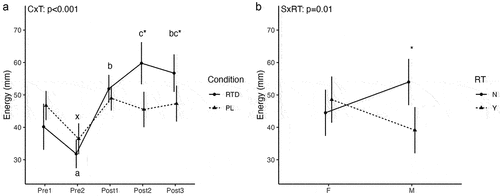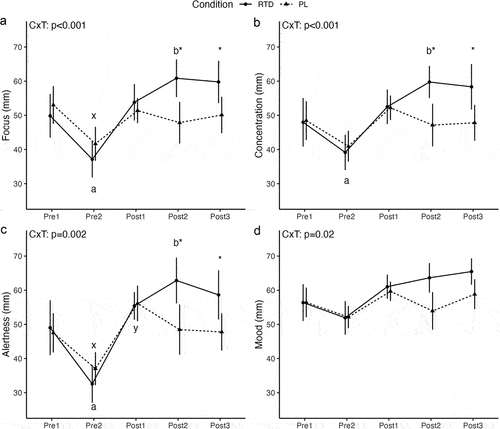Figures & data
Table 1. Overview of study visit procedures.
Table 2. Participant Characteristics.
Table 3. Nutrition facts and ingredients for ready-to-drink beverage1.
Figure 1. Metabolic and hemodynamic outcomes. Letters within a condition (i.e. a, b, c for the RTD condition and x, y, z for the PL condition) indicate differences relative to the baseline assessment within that condition, with different letters indicating significantly different points. Asterisks indicate a significant difference between conditions at a given time point. Error bars are within-subjects error bars due to the design of the study. RTD: ready-to-drink beverage; PL: placebo beverage; REE: resting energy expenditure; RQ: respiratory quotient; HR: heart rate; SBP: systolic blood pressure; DBP: diastolic blood pressure; CxT: condition × time interaction; S: sex main effect; F: female; M: male; T: time main effect; RT status: RT main effect; RT: resistance-trained; nRT: nonresistance-trained.

Figure 2. Subjective Energy. Letters within a condition (i.e. a, b, c for the RTD condition and x, y, z for the PL condition) indicate differences relative to the baseline assessment within that condition, with different letters indicating significantly different points. Asterisks indicate a significant difference between conditions at a given time point. Error bars are within-subjects error bars for panel a and model error bars for panel B. CxT: condition × time interaction; SxRT: sex × resistance training status interaction. RT: resistance training status (Y=resistance-trained; N=nonresistance-trained); F: female; M: male.

Figure 3. Subjective focus, concentration, alertness, and mood. Letters within a condition (i.e. a, b, c for the RTD condition and x, y, z for the PL condition) indicate differences relative to the baseline assessment within that condition, with different letters indicating significantly different points. Asterisks indicate a significant difference between conditions at a given time point. Error bars are within-subjects error bars for panel a and model error bars for panel B. CxT: condition × time interaction.

